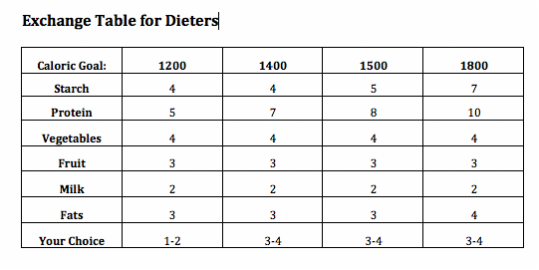
The The American Diabetes Association and The American Dietetic Association got it right all those years ago when they presented the first Exchange Program for diabetics. Dieters quickly realized how useful an Exchange Plan can be when one hopes to lose weight via a healthy, habit-forming diet plan.
Using an Exchange Plan works because you start learning to recognize a portion and, right off the bat, you start putting together your daily meals with real food – and food that you’ve chosen! Once you’ve finished losing weight, you’re already doing what you need to do to maintain your new weight.
So what’s the catch? There are two, really.
First, you have to use self-control to ensure your success. It’s easy to say, “I want to lose a few pounds.” It’s more difficult to actually convince yourself of that when you can’t get your mind off the ice cream in the freezer. But you’ve got this! You can make it happen this time!
Second, you need to learn how to work your exchanges. It’s fairly simple; but it does take some time – and at first a lot of thought. We’ll get you started! It’s fairly straight forward but it’s like playing Pente - easy to learn yet a lifetime to master. But really. Once you have this down, you’ll find that it’s kind of fun (in a challenging way) to fit together the pieces of your nutritional health on a daily basis.
Here is how is works:
Step 1: Figure out how many calories you should be eating each day to reach your goal. Calorie Calculators will calculate your caloric intake needs based on your gender, height, weight, and weight loss goal. It sounds complicated, but it really isn't. It only take a few seconds.
Using an Exchange Plan works because you start learning to recognize a portion and, right off the bat, you start putting together your daily meals with real food – and food that you’ve chosen! Once you’ve finished losing weight, you’re already doing what you need to do to maintain your new weight.
So what’s the catch? There are two, really.
First, you have to use self-control to ensure your success. It’s easy to say, “I want to lose a few pounds.” It’s more difficult to actually convince yourself of that when you can’t get your mind off the ice cream in the freezer. But you’ve got this! You can make it happen this time!
Second, you need to learn how to work your exchanges. It’s fairly simple; but it does take some time – and at first a lot of thought. We’ll get you started! It’s fairly straight forward but it’s like playing Pente - easy to learn yet a lifetime to master. But really. Once you have this down, you’ll find that it’s kind of fun (in a challenging way) to fit together the pieces of your nutritional health on a daily basis.
Here is how is works:
Step 1: Figure out how many calories you should be eating each day to reach your goal. Calorie Calculators will calculate your caloric intake needs based on your gender, height, weight, and weight loss goal. It sounds complicated, but it really isn't. It only take a few seconds.
- Do you like to use Apps? You might want to check out Noom for androids or Noom for iphone.
- Do you prefer on-line Calorie Counters? Here is one of our favorite Calorie Counters that you can use right now.
Really. Memorize them. They are your new best friends. They will be there for you when you find yourself wondering what to eat, out to lunch with a friend, or planning meals for your family. Once you’ve met your goal, you’ll need to revisit the both the Calorie Calculator and the Caloric Goals to maintain your new weight. Simple, straightforward, and successful.
Step 3: Stay Real. The reason we like the recommended on-line Calorie Calculator is because it will nicely tell you no when you select an unrealistic goal. Do yourself a favor and be willing to tell yourself no, too. Never dip under the 1200 calorie goal unless you have been advised to do so by a medical doctor.
Stay tuned and tomorrow we’ll provide you a list of foods and describe how to exchange them.
Step 3: Stay Real. The reason we like the recommended on-line Calorie Calculator is because it will nicely tell you no when you select an unrealistic goal. Do yourself a favor and be willing to tell yourself no, too. Never dip under the 1200 calorie goal unless you have been advised to do so by a medical doctor.
Stay tuned and tomorrow we’ll provide you a list of foods and describe how to exchange them.


 RSS Feed
RSS Feed